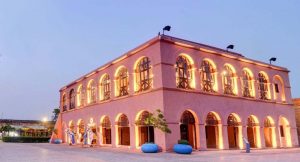Indian Art and Culture: Historical Building in India
When one thinks of art and culture, one usually paintings behind glass walls in museums. However, the most important and revealing creations of any civilization is often the monuments and public spaces that it builds out of stone and mortar. These living monuments are testament to life in the earlier time period and serve as a reliable guide in understanding the life and times of our ancestors.
India is a treasure trove of forts and palaces and if you are interested in visiting some of the most historically important places here, you can start with Fort Gobindgarh in Amritsar. This is an impressive and important structure that was central to the erstwhile Sikh Empire in thee parts and has come to define India’s wondrous architecture and tradition. It is especially significant for Punjabis and Sikhs as the history of this place is intertwined with the labyrinthine walls of the fort that looks over it.
About Fort Gobindgarh
The fort is said to have been built in 1760 but the origins of the fort are probably older. Old monuments are almost never built from scratch and instead evolve over thousands of years, much like the culture and tradition of a place. The site where the fort is located is of strategic importance and there was probably some settlement or military installation here before it was made into a fort by the Bhangi Misl of Amritsar.
This Misl or Sect was entrusted with the defense of the city of Amritsar, its people and its religiously significant sacred spaces. The Bhangis built an impressive monument that must have been quite formidable at the time. This stopped the waves of foreign invaders who travelled though the Himalayas to attack the city, which lay along the famous old Trunk Road. It was this monument that watched over Amritsar and allowed it to develop into a rich and prosperous center of Sikhism.

The next phase in the history of Fort Gobindgarh came when it was taken over by the Sikh Empire and used to store its vast collection of armaments and treasures. It was rebuilt and improved upon with modern methods and technologies from Europe. It is said that the famous Sikh Warrior Maharaja Ranjit Singh himself oversaw the renovation of the fort and hired several Europeans including French architects to give the fort some unique advantages in battle.
All empires eventually come to an end and after a long reign over most of east India, the fort finally fell to the British in the 1850 after the great mutiny. The British realized the strategic and cultural significance of the fort and made several improvements to the structure including making roofs, adding stairways and also adding quarters for staff and soldiers. They used the fort as a military installation and this practice continued after independence.
After independence, the Indian army took control of the fort and used it to house soldiers and to train them for war. The property was understood to have cultural and historical importance and was finally restored and open to the public on 10th February, 2017. Since then, it has attracted tourists from all over India and has become a major tourist attraction in Amritsar.
How to vist the fort
Nowadays, anyone can go to the fort and enjoy a bouquet of services and fun activities that will keep you busy for the whole day. Besides learning more about the fort, guests can also go on camel rides, horse rides, visit museums, go on guided tours and see cultural shows that highlight the history of the fort. Unlike some other monuments, it is very convenient to visit the fort because all amenities such as food, water, restrooms, medical facilities and tourist information is freely available here for a hassle free trip.
Visitors can buy a day pass at the gate and spent as much time here as they like. They can shop at the boutique-shopping gallery inside the fort or visit Zaika Gali for tasty street food from all over India. They can also enjoy a fine dining experience at Kesariya Darbar with an upscale environment and a top-notch menu. Regardless of if you are visiting with family, a big group or with colleagues, you will find the place comfortable and welcoming at all times.

Children are especially attracted to the fort because it brings up the specter of the many wars and sieges fought here. The real artifacts at the museums and the replica Zamzama Cannon inside the fort provides tactile evidence of the important historical events that transpired here and forever changed the course of history. A single visit to Fort Gobindgarh can be more inspirational and educational for children than simply learning about it in history books. If you want to imbibe art and culture in the new generation, this is the best way to do it.
